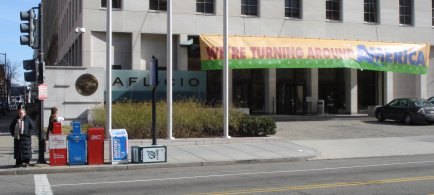Energy transitions take a lot of time and we won’t have that green energy anytime soon. That was the sobering message I heard at the lecture today by Vaclav Smil, from the University of Manitoba. I went to hear his talk, Energy Transition: the Time Factor, today at AEI.
Below are energy saving devices. I will be riding my real bike soon and I figure that I can walk anyplace that one of these little bikes can take me, but I think that Smartbike is a good idea.

It took nearly 400 years for England to covert from wood to coal. The U.S. didn’t get more energy from coal than from wood until 1884, and still has not really left the age of coal, since more than half of our electricity comes from coal fired thermal plants. Things take time for a variety of reasons.
Many enabling factor are necessary for an energy transformation to take place. A resource that cannot be brought to market is useless and sometimes transport is a limiting factor. That was the problem for natural gas. Oil and gas are often found together. In the old days, the oil could be shipped in tanks or barrels. There was often nothing they could do with the gas, so they just flared it. Gas couldn’t be transported until particular alloys and welding techniques developed that could move it under pressure and this didn’t happen until the 1930s. Even then, it took time to construct the network. W/o these things gas was useless even if it was essentially free at the well-head, demonstrating once again that a resource is not a resource until the technology is available to make it so.

Now You’re Cooking With Gas
Once the pipes were in place, gas became available around the country. In the 1940s, there was a phrase – “now you’re cooking with gas”– that implied you were up to date. Gas had been abundantly available for more than fifty years, but not accessible. Even then, it still took many years for most houses to get hooked up to gas. Some of our neighbors were still burning coal to heat their houses well into the 1960s.
Natural gas can now be piped long distances because of better compression engines. Back in the 1980s, President Reagan tried to block Soviet access to modern compressor technology. The got the engines in Europe so that today the cappuccino you buy in Italy is probably warmed with Russian natural gas.
BTW – recent technological improvements allow gas to be more easily shipped in tankers. Using more gas in place of oil requires less of a shift, so our energy future may be gassier.
BTW 2 – they talked re methane hydrates. I didn’t know what that was, so I looked it up. This is the link. This is evidently a big potential source of natural gas, although I saw something on the Science Channel talking re how melting of methane on the ocean bottom had caused the great extinction at the end of the Paleozoic Era, so I don’t know.
Below – this and the next picture are union representations near the White House. Unions are enthusiastic about getting jobs back and counting on the new energy infrastructure to help.

Professor Smil didn’t have much confidence in solar or wind power. These things, he said, have significant problem with availability (wind doesn’t always blow and he sun doesn’t shine at least half the time.) But the bigger challenge is transport. It is analogous to the problem with natural gas. The wind blows the strongest where there not many people and we don’t have the transmission lines to move the power. The same goes for surfaces where solar could be placed. Beyond that, both types of energy are small scale and locally intrusive. You will need lots of lines and lots of machines. Some of the people who love wind or solar in theory object when it ruins their view, as Edward Kennedy did when he squashed a wind project near his home in Massachusetts. Everybody lives somewhere and many places where the wind blows best have some rich guys nearby who can stop the project.

We also do not have a real electricity grid in America. We have separate local grids and the connections go north-south. This means that Canadian hydropower can move from Ontario to Florida or from British Columbia to California, but you probably could not power your I-pod on the electricity you could move west-east from windy North Dakota to busy New York.
Probably the most significant thing that will slow our energy transition is what we already have. We have thermal plants. We have paid the up-front investment costs and the variable costs are a lot lower. Think of it in terms of your biggest investment – your house. If you build a new house, you will be wise to incorporate energy saving devices, but it is probably a bad idea to tear your house down and spend hundreds of thousands of dollars to build a new one just to save a couple hundred dollars a year. You will wait until your house “wears out” and that might be a long time. What does that say about the speed of transition?
Smil thinks that we will be a fossil fuel society for a long time to come. The most effective thing we can do in the short run is conservation that makes fossil fuels use more efficient. We can use more natural gas and we can make engines much more efficient, especially if we switch to diesel engines. Americans are prejudiced against diesel, but up-to-date engines have greatly improved in terms of performance and pollution and they get much better mileage than their gasoline counterparts. My first car was a diesel. We were very happy with it.
BTW – T Boone Pickens disagrees. Read re the Pickens Plan at this link. I like the idea of the Pickens Plan better, but I am afraid I think Smil is probably closer to right for the short and medium-term.
Of course, nuclear energy is very efficient, creates no green house gases and can work with the current electrical infrastructure, but some influential Americans harbor a hateful grudge against nukes. The French get 75%+ of their electricity from nuclear. I always figured that if the French could do it, so could we. Guess not. Viva la France.
